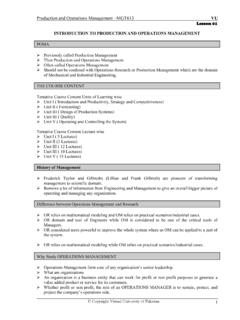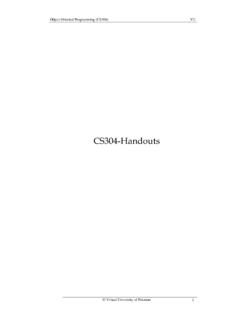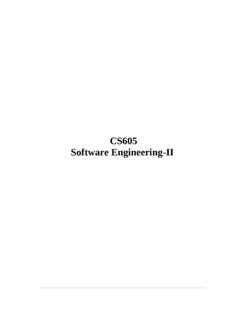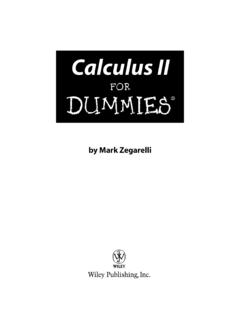Transcription of Calculus - 5th Edition - Schaum Series
1 Page intentionally left blank EditionFrank Ayres, Jr., PhDFormerly Professor and Head of the Department of MathematicsDickinson CollegeElliott Mendelson, PhDProfessor of MathematicsQueens CollegeSchaum s Outline SeriesNew York Chicago San Francisco Lisbon LondonMadrid Mexico City Milan New Delhi San JuanSeoul Singapore Sydney 2009, 1999, 1990, 1962 by The McGraw-Hill Companies, Inc. All rights reserved. Manufactured in the United States of America. Except as permitted under the United States Copyright Act of 1976, no part of this publication may be reproduced or distributed in any form or by any means, or stored ina database or retrieval system, without the prior written permission of the publisher. 0-07-150862-7 The material in this eBook also appears in the print version of this title: trademarks are trademarks of their respective owners.
2 Rather than put a trademark symbol after every occurrence of a trademarked name, we use names inan editorial fashion only, and to the benefit of the trademark owner, with no intention of infringement of the trademark. Where such designations appear in thisbook, they have been printed with initial caps. McGraw-Hill eBooks are available at special quantity discounts to use as premiums and sales promotions, or for use in corporate training programs. For moreinformation, please contact George Hoare, Special Sales, at or (212) 904-4069. TERMS OF USE This is a copyrighted work and The McGraw-Hill Companies, Inc. ( McGraw-Hill ) and its licensors reserve all rights in and to the work. Use of this work issubject to these terms. Except as permitted under the Copyright Act of 1976 and the right to store and retrieve one copy of the work, you may not decompile,disassemble, reverse engineer, reproduce, modify, create derivative works based upon, transmit, distribute, disseminate, sell, publish or sublicense the work orany part of it without McGraw-Hill s prior consent.
3 You may use the work for your own noncommercial and personal use; any other use of the work is strictlyprohibited. Your right to use the work may be terminated if you fail to comply with these terms. THE WORK IS PROVIDED AS IS. McGRAW-HILL AND ITS LICENSORS MAKE NO GUARANTEES OR WARRANTIES AS TO THE ACCURACY,ADEQUACY OR COMPLETENESS OF OR RESULTS TO BE OBTAINED FROM USING THE WORK, INCLUDING ANY INFORMATION THAT CANBE ACCESSED THROUGH THE WORK VIA HYPERLINK OR OTHERWISE, AND EXPRESSLY DISCLAIM ANY WARRANTY, EXPRESS ORIMPLIED, INCLUDING BUT NOT LIMITED TO IMPLIED WARRANTIES OF MERCHANTABILITY OR FITNESS FOR A PARTICULAR and its licensors do not warrant or guarantee that the functions contained in the work will meet your requirements or that its operation will be unin-terrupted or error free. Neither McGraw-Hill nor its licensors shall be liable to you or anyone else for any inaccuracy, error or omission, regardless of cause, inthe work or for any damages resulting therefrom.
4 McGraw-Hill has no responsibility for the content of any information accessed through the work. Under no circumstances shall McGraw-Hill and/or its licensors be liable for any indirect, incidental, special, punitive, consequential or similar damages that result fromthe use of or inability to use the work, even if any of them has been advised of the possibility of such damages. This limitation of liability shall apply to anyclaim or cause whatsoever whether such claim or cause arises in contract, tort or otherwise. DOI: hope you enjoy thisMcGraw-Hill eBook! Ifyou d like more information about this book,its author, or related books and websites,please click to learn more? purpose of this book is to help students understand and use the Calculus . Everything has been aimed toward making this easier, especially for students with limited background in mathematics or for readers who have forgotten their earlier training in mathematics.
5 The topics covered include all the material of standard courses in elementary and intermediate Calculus . The direct and concise exposition typical of the Schaum Outline Series has been amplified by a large number of examples, followed by many carefully solved prob-lems. In choosing these problems, we have attempted to anticipate the difficulties that normally beset the beginner. In addition, each chapter concludes with a collection of supplementary exercises with answers. This fifth Edition has enlarged the number of solved problems and supplementary exercises. Moreover, we have made a great effort to go over ticklish points of algebra or geometry that are likely to confuse the student. The author believes that most of the mistakes that students make in a Calculus course are not due to a deficient comprehension of the principles of Calculus , but rather to their weakness in high-school algebra or geometry.
6 Students are urged to continue the study of each chapter until they are confident about their mastery of the material. A good test of that accomplishment would be their ability to answer the supplementary author would like to thank many people who have written to me with corrections and suggestions, in particular Danielle Cinq-Mars, Lawrence Collins, De Jonge, Konrad Duch, Stephanie Happ, Lindsey Oh, and Stephen B. Soffer. He is also grateful to his editor, Charles Wall, for all his patient help and MENDELSONC opyright 2009, 1999, 1990, 1962 by The McGraw-Hill Companies, Inc. Click here for terms of use. page intentionally left blank 1 Linear Coordinate Systems. Absolute Value. Inequalities 1 Linear Coordinate System Finite Intervals Infinite IntervalsInequalitiesCHAPTER 2 Rectangular Coordinate Systems 9 Coordinate Axes Coordinates Quadrants The Distance Formula The Midpoint Formulas Proofs of Geometric TheoremsCHAPTER 3 Lines 18 The Steepness of a Line The Sign of the Slope Slope and Steepness Equations of Lines A Point Slope Equation Slope Intercept Equation Parallel Lines Perpendicular LinesCHAPTER 4 Circles 29 Equations of Circles The Standard Equation of a CircleCHAPTER 5 Equations and Their Graphs 37 The Graph of an Equation Parabolas Ellipses Hyperbolas Conic SectionsCHAPTER 6 Functions 49 chapter 7 Limits 56 Limit of a Function Right and Left
7 Limits Theorems on Limits InfinityCHAPTER 8 Continuity 66 Continuous FunctionCHAPTER 9 The Derivative 73 Delta Notation The Derivative Notation for Derivatives DifferentiabilityCHAPTER 10 Rules for Differentiating Functions 79 Differentiation Composite Functions. The Chain Rule Alternative Formu-lation of the Chain Rule Inverse Functions Higher DerivativesFor more information about this title, click 11 Implicit Differentiation 90 Implicit Functions Derivatives of Higher OrderCHAPTER 12 Tangent and Normal Lines 93 The Angles of IntersectionCHAPTER 13 Law of the Mean. Increasing and Decreasing Functions 98 Relative Maximum and Minimum Increasing and Decreasing FunctionsCHAPTER 14 Maximum and Minimum Values 105 Critical Numbers Second Derivative Test for Relative Extrema First De-rivative Test Absolute Maximum and Minimum Tabular Method for Find-ing the Absolute Maximum and MinimumCHAPTER 15 Curve Sketching.
8 Concavity. Symmetry 119 Concavity Points of Inflection Vertical Asymptotes Horizontal As-ymptotes Symmetry Inverse Functions and Symmetry Even and Odd Functions Hints for Sketching the Graph of y= f (x) chapter 16 Review of Trigonometry 130 Angle Measure Directed Angles Sine and Cosine FunctionsCHAPTER 17 Differentiation of Trigonometric Functions 139 Continuity of cos x and sin x Graph of sin x Graph of cos x Other trig -onometric Functions Derivatives Other Relationships Graph of y=tanx Graph ofy = secx Angles Between Curves chapter 18 Inverse Trigonometric Functions 152 The Derivative of sin 1x The Inverse Cosine Function The Inverse Tan-gent FunctionCHAPTER 19 Rectilinear and Circular Motion 161 Rectilinear Motion Motion Under the Influence of Gravity Circular MotionCHAPTER 20 Related Rates 167 chapter 21 Differentials.
9 Newton s Method 173 The Differential Newton s MethodCHAPTER 22 Antiderivatives 181 Laws for 23 The Definite Integral. Area Under a Curve 190 Sigma Notation Area Under a Curve Properties of the Definite IntegralCHAPTER 24 The Fundamental Theorem of Calculus 198 Mean-Value Theorem for Integrals Average Value of a Function on a Closed IntervalFundamental Theorem of Calculus Change of Variable in a Defi-nite IntegralCHAPTER 25 The Natural Logarithm 206 The Natural Logarithm Properties of the Natural LogarithmCHAPTER 26 Exponential and Logarithmic Functions 214 Properties of exThe General Exponential Function General Logarithmic FunctionsCHAPTER 27 L H pital s Rule 222L H pital s Rule Indeterminate Type 0 Indeterminate Type Indeterminate Types 00, 0, and 1 chapter 28 Exponential Growth and Decay 230 Half-LifeCHAPTER 29 Applications of Integration I.
10 Area and Arc Length 235 Area Between a Curve and the y Axis Areas Between Curves Arc LengthCHAPTER 30 Applications of Integration II: Volume 244 Disk Formula Washer Method Cylindrical Shell Method Difference of Shells Formula Cross-Section Formula (Slicing Formula) chapter 31 Techniques of Integration I: Integration by Parts 259 chapter 32 Techniques of Integration II: Trigonometric Integrands and Trigonometric Substitutions 266 Trigonometric Integrands Trigonometric SubstitutionsCHAPTER 33 Techniques of Integration III: Integration by Partial Fractions 279 Method of Partial FractionsCHAPTER 34 Techniques of Integration IV: Miscellaneous Substitutions 35 Improper Integrals 293 Infinite Limits of Integration Discontinuities of the IntegrandCHAPTER 36 Applications of Integration III: Area of a Surface of Revolution 301 chapter 37 Parametric Representation of Curves 307 Parametric Equations Arc Length for a Parametric CurveCHAPTER 38 Curvature 312 Derivative of Arc Length CurvatureThe Radius of Curvature The Circle of Curvature The Center of Curvature The EvoluteCHAPTER 39 Plane Vectors 321 Scalars and Vectors Sum and Difference of Two Vectors Components of a Vector Scalar Product (or Dot Product)











